Hallucinations, a blog about writing, trains, and Wire to Wire
Browsing Category: Trains
Stations of the Heart
Thinking about the Amtrak Writer’s Residency has reminded me of train trips and railroad stations in my past. Some of which I’ve never written about.
The country’s oldest continually operated train station is in my hometown—Jackson, Michigan. When I was going to college, my girlfriend and I often travelled by train, and train stations were sometimes places of sad parting.
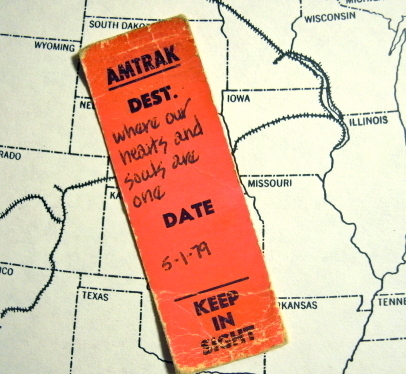
After one trip, my girlfriend took a spare seat marker tag—a little stub the conductor puts by your seat to indicate where you’re going—and wrote a note on it, so I’d remember her when we were apart. After the word Destination, she wrote:
Where our hearts and souls are one."
That was 1979. We moved in together later that year, got married after that. The Amtrak stub says “Keep In Sight,” and I do. Her note is always on my shelf, where I can see it when I write. Our hearts and souls are still together, and always will be. I can hear her in the next room as I type this.
__________
One thing that struck me is that I’ve written a lot about trains, but very little about stations. I was thinking about that last week, when I met my wife at King Street Station in Seattle during the week of AWP, the national writer’s conference. The station looks great now, after a $50 million-dollar renovation. Harriet and I lived in Seattle ten years before moving to Portland, and there were a lot of partings and reunions in that station.

Union Station in Portland is also something to be proud of. Last year on Train Day, we saw the White Bird dance company perform Le (Petite) Grand Continental with a hundred or more dancers.
It’s also where I chose to pass out free books on World Book Night. I went up to people in the station and offered them a copy of Alexis Smith’s great book, Glaciers—because what better place to read than on a train. Even the Amtrak ticket clerks took copies, and I ran out right away.
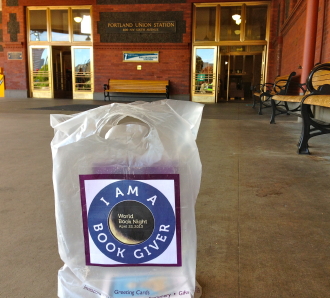
Outside Union Station. You can see the last copy of Glaciers in the bag.
__________
The residency application also made me re-read the first story I ever published, a short piece that won a Seattle Arts Commission grant. It’s called “It Was A New Time,” and it was the basis for what became Wire to Wire.
It’s not available in print anymore, but here’s how it starts.
It was a new time and we rode slam hard, rode it on flatcars and hoppers and bulkhead flats, in empty woodchip cars, gons, auto ramps, and piggies all over the west, the prairies and dirty western towns of district nine—Kalama, Lillooet, Sutter’s Portage, dozens of towns seen from the frame of a boxcar and eyes numb past blinking. Towns of dust, where dirty kids threw rocks at the train—in laziness, not maliciously—and empty towns on the straight flat where the last lit beer sign burned 30 miles into the night. We rode quartermile track, Coe and I, seamlessly rolled rail laid eight to a measure. Every seven seconds on alternate sides of the car, we hit the end of one of those quartermile sections of rail, hit a beautiful ringing rimshot of metal and speed over cement-tied Great Slave track. But time was a fitful helmsman that summer and had not always run so new.
Those beautiful ringing rimshots that train wheels make on the track—I hope to hear them again soon.
__________
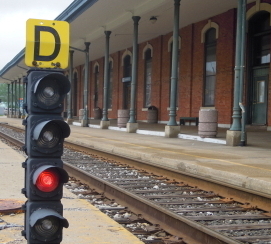
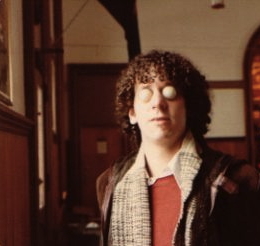
The Jackson, Michigan Amtrak station in 2011, and me inside the station in the 1970s. With ping pong balls over my eyes. Because the "Relaxation Expert" where I worked said that was a good way to relieve stress. It wasn't—but it was good for a laugh.
__________
Love and trains, the two great themes. "When the train left the station, it left two lights on behind..."
Posted in Trains
The road begins and ends in McMinnville
On a summer night in 1989, the freight-riding careers of Spider Rider and Iron Legs Burk came to an end in McMinnville, Oregon. We were two Michigan kids who lived near the tracks and fell in love with trains in the early ‘70s. We both ended up – or ended up so far – in Oregon.
Nights and weekends, when we were young – when we should have been chasing girls, drinking beer, or stealing cars – we’d steal away to the railroad tracks instead and grab ladder rides. One day, we got in a boxcar and rode a couple hundred miles down to Elkhart, Indiana and back. When I got home, and my parents asked what I'd been up to, I answered, "Hangin' out with Deeg." That was his nickname. Freight stories were shared on a need-to-know basis back then, and our parents didn't need to know. They certainly didn't need to know our freight-hopping names.
After that, we were hooked, and we rode everywhere. Durand, Owosso, St. Paul, East Dubuque, Minot, Havre, Yakima, Spokane, Eureka, Petaluma, San Luis Obispo, Sacramento, Bakersfield, Barstow, Salt Lake City, Santa Fe, Denver, Grand Junction, Omaha – more towns than I can remember, though they're written in our journals. And all across Canada: Kamloops and Moose Jaw and Medicine Hat and…well, the unit trains, the one-a-days, the slugs, and the hotshots. Any train with fresh orders and hoses hooked, we rode.
______
By 1989, things had changed. We both had jobs. Jesse was married and I was about to be. Boxcars were in short supply, replaced by container trains, and empties were rarer still. And we had lost a step or two, or at least I had.
But one day, Jesse – Iron Legs – put out the call, as he always did. One more trip. Portland to McMinnville. Leave work early. Meet me on the bridge. I said yes, as I usually did.
We rode south and west all afternoon and into the evening, and when we jumped out in McMinnville, we might have said something like, "Maybe that’ll be the last time ever." If that's what we said, we probably didn’t really believe it. But here it is, twenty-plus years later, and our freight-riding days seem to be done. You never know, though – we’ll both be in Michigan this summer, and if Jesse sees a slow-moving freight, well...I'll keep you posted. As things stand now, though, McMinnville was the end of the road.
______
So perhaps it's fitting that on June 16, at Third Street Books, McMinnville will be the beginning of the road for the Wire to Wire bookstore tour. Sure, there were a couple of warm-up dates out east last month. I read with a group of terrific Tin House writers at WORD in Brooklyn and the KGB Bar in Manhattan. Good places to loosen up and test things out.

But McMinnville will be the first Oregon date, and the first time I read solo. Not even Iron Legs Burk will be there.
It’s being billed as a workshop/reading, where I’ll tell you everything I know about crime novels, which won’t take long. So if you’re anywhere near Third Street Books in McMinnville, Oregon on June 16, stop in and say hello.
When it’s done, I’m taking a walk down to the freight yard for old time’s sake, and you’re welcome to come along.
_______________

Iron Legs Burk in Oregon: Wanting things that can only be found in the Darkness on the Edge of Town.
Posted in Trains | Wire to Wire
The Strip Club and the Grange
Okay, I didn’t actually do a reading in a strip club, despite various statements that I may have made on Facebook and elsewhere. Not everything you read online is true – I mean, I'm trying to promote a book here.
And technically, I did do a little reading in a strip club – Portland’s Club Rogue – but only as part of a video shoot for the book trailer. No one else was there except the film crew from Juliet Zulu, Tony Perez from Tin House, and Sandria Dore, a dancer who was oddly unimpressed to meet an author. Although that was in the script, so maybe she was just staying in character.
We were filming in Club Rogue because Michael Slater, one of the main characters in Wire to Wire, has a habit of going to strip clubs at various points in the book. He doesn’t go to see naked women, however. He goes there to feel the fear of exposing his loneliness and need:
“One dancer in particular had his number. She made him look left, she made him look right. She had him on a little string. She was extremely good-looking and the fear she inspired scoured a month of crap off his soul.”
.jpg)
And yes, that's a Bob Seger t-shirt I'm wearing. Perhaps another reason why the stripper ignored me.
After the shoot, just to see what it felt like, I stood by the pole and read to the empty room as the film crew packed up. I’ll be replicating this experience in bookstores soon, minus the pole, but hopefully with an audience. The tour schedule is here. Come and make it rain.
_____
I did, however, read, at the Springwater Grange in Estacada, Oregon, last Saturday night. Friends, acquaintances, and passers-by who were quick to believe that I gave a reading in an empty strip club were suddenly doubtful when I claimed to have read in the Grange Hall. People, you’ve got it backward – the Grange was amazing. Writers Night at the Grange was like three levels better than the best reading you can possibly imagine.
It attains that status through the goodwill, generous heart and friendship of Stevan Allred, who has organized the event for the Estacada Area Arts Commission for the past nine years, and from Joanna Rose, author of Little Miss Strange, who teaches with Stevan at the Pinewood Table and shares the stage with him at the Grange.
Every year, a third person is invited to join in reading – often one of their students – and this year it was me. Go ahead, take a guess as to how many people come out on a Saturday night in Estacada to hear writers read. Nope, you’re low. Double it. Still low. I counted nearly 70 people. It was an amazing experience – a perfect, confidence-building way to debut Wire to Wire and start the book tour.
The theme of the night was On the Road. Joanna read a beautiful piece about a road trip through rural Oregon, snow, and memories. Stevan read an essay about a real 1970s freight-hopping trip that took me back to my youth – reminding me that, originally, I jumped freight trains for the same reason Slater visits strip clubs – to scour the fear off my soul.
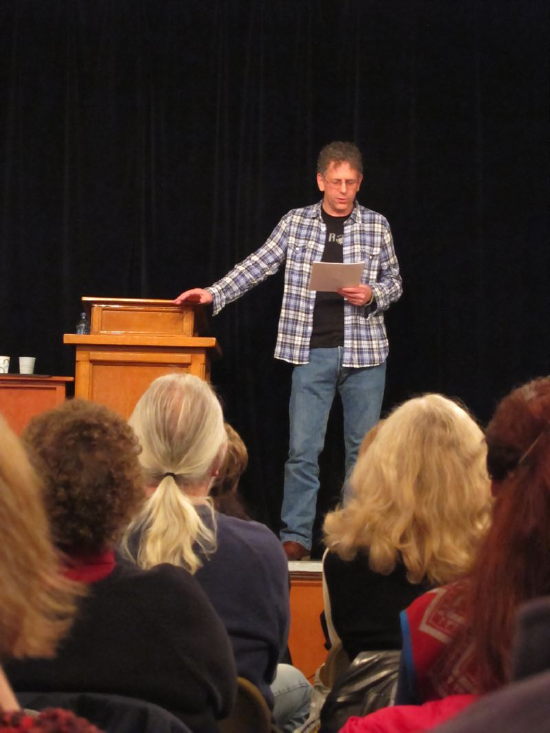
After the reading, there was a huge party at Stevan’s house, as there is every year. When I say it was a terrific time, that’s true. When I say I regret starting a fight and stabbing a guy, that’s not. But feel free to spread the rumor. I’ve got a book to promote, and I could use the buzz.
Thanks to Juliet Zulu for the production still at Club Rogue, and fellow writer and previous Grange-reader Steve Denniston for the shot of me at the podium.
_________

Say it takes you an hour to drive through rural Oregon to the Springwater Grange. Say you've been waiting for this all your life. Roll down the window and play this fucking loud. Steve Earle, "Feel Alright."
Posted in Trains | Wire to Wire | Writing
Climbing Rex Hill
The last time I took a freight trip with Iron Legs Burk was in 1989. I cut out of work early and met him on the railroad bridge that crosses the Willamette River south of Portland. We figured the train would slow for the bridge – enough, we hoped, to let us jump it.
By ’89, freights were running without cabooses. Instead of a cab, there was a flatcar with a dinky red light at the end of the train. The set-up was tragic and pathetic – the noble caboose discarded. But it made catching a ride somewhat easier. We just let the whole train pass, then chased down the flatcar.
Jesse, aka Iron Legs, climbed on first, then I grabbed the short rear ladder. I’d lost a step, maybe, and my momentum didn’t quite carry me all the way up, so Jesse put out a hand and gave a pull. That was the first and only time I ever needed help hopping a freight, and maybe a good signal that it was time to hang it up.
When we got to McMinnville, we hopped out, walked through town, and hit a bar, and eventually called my girlfriend for a ride back to Portland. It’s possible I’d forgotten to tell her about our freight plans, because she was not happy about having to drop everything and come pick us up. But she did. We’re still together and it remains on the list of bad things I’ve done.
It was a beautiful ride, though. A crisp August day through great country. That’s me in what we used to call a deep-dish gondola. If you look closely, you can see the trestle we’re crossing. Iron Legs Burk says this photo was taken climbing Rex Hill near Newberg, Oregon, and I believe him.
.jpg)
Photo by D.C. Jesse Burkhardt
___________
Summer, freights, bars, girlfriends: "It Takes a Lot to Laugh, It Takes a Train to Cry."
Posted in Trains
Riding the Ann Arbor
A postcard from my wife – well, she was my girlfriend at the time, and we had just finished our only freight ride together: hopping the Ann Arbor Railroad from southern Michigan to Frankfort, where Wire to Wire is set. (It’s called Wolverine in the book.) The 250-mile trip took 24 hours.


The postcard is to my parents. They knew we were hopping freight. They didn’t know about us getting caught when we tried to change cars at Whitmore Lake, or the ankle bracelet lost in a boxcar, or the angry engineer who threw us off the train in Owosso, or how we sat at an all-night donut shop with no idea what to do next until the young brakeman happened to come in and told us how to sneak back into the yards. Parents don’t need those kind of details. The note my girlfriend/wife wrote – that the trip was “easy and hard” – says it all.
Frankfort/Elberta is where the Lake Michigan railroad ferries dock. We spent a few nights sleeping on the beach and in the trailer my parents kept in a small camp up north, then rode the ferry to Wisconsin, where we ran into a lot more things that were easy and hard, and parted ways – but not for long – in Milwaukee.

The schematic is something Iron Legs Burk and I found in a locker years later in the abandoned engine house in Elberta. It was helpful in writing Wire to Wire in that it showed the dimensions of the ferries. And for the phrase, “twin screw,” which turns up in some dialogue. “The old twin screw.” Two propellers, that is.
___________
Sometimes love was a train and vice versa, but mostly it wasn't: "If Love Was A Train," by Michelle Shocked
Posted in Trains | Wire to Wire
Listen to the track
Trains change when you’re close enough to touch them. The sound is different, for one thing. The roar that seems like a single thing from afar turns out to have ten layers, at least, and sometimes more. There are multiple saxophones going, and many guitars and drummers, and there are even delicate parts that are hard to hear until they hook you and then become hard not to hear.
The sound changes again if you’re actually on the train, because the interplay of train and track is reversed.
The thing to remember is that trains play the track. Like a bow on a string, except they’re both made of steel. When you’re on the train, you hear the specific rhythm of your car – and the three or four cars around you – hitting all kinds of track. The iron rail gives a little under the weight of the train, and as you move down the line, the wheels hit the joints between rails in an ever-changing drum solo.
When you’re on the ground, what you hear is the same section of track being hit by all different kinds of cars. The pattern is a little more predictable, but just as hypnotic. For me, anyway, and maybe for you too.
Warren Zevon’s brilliant lyrics to “Nighttime in the Switchin’ Yard” got this perfectly:
Listen to the train
Listen to the train
Listen to the train
Listen to the track!
Listen to the track, he said. Only someone who had actually listened, carefully and specifically, to a moving freight would get that distinction. When I first heard that line, I wondered why Zevon would write a lyric that would only make sense – only really ring true – for people like Iron Legs Burk and me, people who had actually ridden freights. But maybe I was giving us too much credit.
Anyway, nothing sounds better than a certain kind of train, unless it’s a great train song. Wire to Wire is full of music, but not train songs per se, so to rectify that, I put a list up on the site. The minute you do something like that, you know you’re gonna leave out some good ones. And sure enough, after just a couple of weeks, readers have suggested several additions.
Mike M. – a longtime reader of my other site – says I should add “The City of New Orleans,” the Arlo Guthrie version. Good call. The list has already been revised.
Fellow writer Nicole R. suggests “Train Song” by Tom Waits: “I know he's someone people either love or hate, but this song is pretty awesome and perfect for his voice.” Agreed.
From Christine P. comes “Bob Dylan's Dream” – he is, after all, on a train headed west, she points out.
And Ears Two – well known to readers of the Segerfile – suggests…well, about fifteen different train songs. As you might expect from someone with encyclopedic pop music knowledge. Many of his nominees will be added in the future.
I’m dead certain the list isn’t complete yet. What else did I miss? Let me know.
_____
In other music feedback, Mike M. points out that “Alice’s Restaurant” was released the year before “2+2=?” – making it an earlier antiwar song than Seger’s track. Fair enough, though I would put “Alice’s Restaurant” more in the folk rock category. Which raises a question: Why was it okay for folk artists to release antiwar protest songs all through the 1960s, while the subject seemed to be off-limits for other genres until about 1969, when Edwin Starr broke through with "War (What Is It Good For?)"
____

Iron Legs Burk on the road. "Train Man," by the Bob Seger System.
Recent Posts
Archives
- December, 2017
- December, 2015
- January, 2015
- November, 2014
- April, 2014
- March, 2014
- December, 2013
- September, 2013
- July, 2013
- March, 2013
- January, 2013
- November, 2012
- October, 2012
- July, 2012
- May, 2012
- March, 2012
- February, 2012
- December, 2011
- November, 2011
- October, 2011
- September, 2011
- August, 2011
- July, 2011
- June, 2011
- May, 2011
- April, 2011
- March, 2011
- February, 2011
- January, 2011
- December, 2010
- ,
Categories
Links
- My Essay on Bloom: No Other Way Out
- Playlist in LargeHearted Boy
- A Book Brahmin Essay for Shelf Awareness
- Powell's Blog: Sex & Money
- Powell's Blog: Riding Freights
- Powell's Blog: Burning Down the House
- Powell's Blog: Bob Seger
- Powell's Blog: Thank You
- An Interview with Kathleen Alcala
- An interview with Laura Stanfill
- Video with Yuvi Zalkow
- Interview with Noah Dundas
- Tin House Blog: Motor City Fiction
- Blog on Occupy Writers
- W2W Essay for Northwest Book Lovers
- W2W Essay for Poets & Writers
- America Reads: Page 69
- America Reads: My book, the movie
- America Reads: What I'm Reading
- Interview with Be Portland
- The Oregonian: Where I Write
 Subscribe to the RSS feed
Subscribe to the RSS feed